Data-Driven Dynamic Bayesian Network Model for Safety Resilience Evaluation of Prefabricated Building Construction
Abstract
1. Introduction
2. Literature Review
2.1. Safety Management of Prefabricated Building Construction
2.2. Safety Resilience in Prefabricated Building Construction
3. Materials and Methods
3.1. Establishment of Evaluation Index System
3.2. Data-Driven Construction of Static BN
3.2.1. Structure Learning
- (1)
- Set algorithm parameters and initialize network structure.
- (2)
- Define tabu table. Create a tabu table to record structures that have been banned from exploration to avoid duplication during the search process.
- (3)
- Determine termination conditions. The algorithm ends when a certain number of iterations is reached or the objective function value becomes stable.
- (4)
- Determine the current solution domain and generate candidate solutions. The algorithm generates a new structure by performing a neighborhood search on the current structure and evaluates its quality via an objective function.
- (5)
- Determine whether the candidate solution satisfies the contempt criterion. The defiance criterion compares the Bayesian scoring function values of two network structures to determine whether to accept a new structure that has been added to the tabu list, preventing the algorithm from missing the possible global optimal solution because it avoids taboo solutions during the search process. Improved algorithm flexibility.
- (6)
- Update tabu list. Update the tabu table with the taboo object corresponding to the new current solution, and then go to step (4).
3.2.2. Parameter Learning
3.2.3. Model Validation
3.3. Construction of DBN
3.3.1. DBN Structure Determination
3.3.2. Transfer Probability Matrix Determination
4. Case Study
4.1. Project Overview
4.2. Resilience Evaluation
4.3. Diagnostic Reasoning
5. Results and Discussions
6. Conclusions
- (1)
- Based on the concept of resilience and its characteristics, combined with the characteristics of prefabricated building construction, the concept of safety resilience of prefabricated building construction is proposed. The evaluation index system of safety resilience of prefabricated building construction is constructed from the absorption capacity, adaptation capacity, recovery capacity, and optimization capacity. This paper integrates the concept of resilience into the safety risk management of prefabricated building construction, improving the existing risk management that only emphasizes prior control and focusing on the construction system’s adaptability to accidents and optimization capabilities. It emphasizes learning the impact experience of disturbance after the accident and improving the adaptability to uncertain events through accident review and learning to achieve system optimization. Resilience engineering is a new path and method for risk management and safety management in the face of increasingly complex socio-technical systems.
- (2)
- Combining the relevant literature and expert knowledge, structure learning by the TS algorithm and parameter learning by the EM algorithm are used to construct a DBN evaluation model for the safety resilience of prefabricated building construction. Compared with traditional BN model construction based on expert experience, data-driven BN construction can learn the structure and parameters of the model from a large amount of actual data without relying on the prior knowledge of domain experts. This makes the model more flexible and adaptable, capable of capturing complex relationships and patterns in the data. At the same time, data-driven BNs allow models to be dynamically updated to reflect changes in new data. This real-time update enables the model to continuously improve and optimize, adapting to changing environments and conditions. This has important implications for decision making and risk management during the construction of prefabricated buildings.
- (3)
- Combined with a specific engineering case, the model obtained the dynamic change curve of the safety resilience of prefabricated building construction when the evidence was input. With the help of the model’s reverse diagnosis reasoning, the top five key resilience factors of the case project were identified from the micro perspective as establishing a resilience safety culture, preventing unsafe behaviors of personnel, safety management and supervision on the construction site, emergency management actions, and building a risk management information system. From a macro perspective, the sensitivity of the four resilience metric nodes is absorption ability, recovery ability, adaptation capacity, and optimization ability from large to small.
Author Contributions
Funding
Data Availability Statement
Conflicts of Interest
References
- Liu, S.; Li, Z.; Teng, Y.; Dai, L. A Dynamic Simulation Study on the Sustainability of Prefabricated Buildings. Sustain. Cities Soc. 2022, 77, 103551. [Google Scholar] [CrossRef]
- General Offifice of the Central Committee of the Communist Party of China, General Offifice of the State Council. Opinions on Promoting the Green Development of Urban and Rural Construction. 2021. Available online: https://www.gov.cn/ (accessed on 21 October 2021).
- Central People’s Government of the People’s Republic of China. Outline of the 14th Five-Year Plan for National Economic and Social Development of the People’s Republic of China and Vision in 2035. 2021. Available online: http://www.gov.cn/ (accessed on 13 March 2021).
- Shahpari, M.; Saradj, F.M.; Pishvaee, M.S.; Piri, S. Assessing the Productivity of Prefabricated and In-Situ Construction Systems Using Hybrid Multi-Criteria Decision Making Method. J. Build. Eng. 2020, 27, 100979. [Google Scholar] [CrossRef]
- Tavares, V.; Soares, N.; Raposo, N.; Marques, P.; Freire, F. Prefabricated versus Conventional Construction: Comparing Life-Cycle Impacts of Alternative Structural Materials. J. Build. Eng. 2021, 41, 102705. [Google Scholar] [CrossRef]
- Fard, M.M.; Terouhid, S.A.; Kibert, C.J.; Hakim, H. Safety Concerns Related to Modular/Prefabricated Building Construction. Int. J. Inj. Control Saf. Promot. 2017, 24, 10–23. [Google Scholar] [CrossRef] [PubMed]
- Wang, J.; Guo, F.; Song, Y.; Liu, Y.; Hu, X.; Yuan, C. Safety Risk Assessment of Prefabricated Buildings Hoisting Construction: Based on IHFACS-ISAM-BN. Buildings 2022, 12, 811. [Google Scholar] [CrossRef]
- Bergström, J.; Van Winsen, R.; Henriqson, E. On the Rationale of Resilience in the Domain of Safety: A Literature Review. Reliab. Eng. Syst. Saf. 2015, 141, 131–141. [Google Scholar] [CrossRef]
- Xu, G. The Construction Site Management of Concrete Prefabricated Buildings by ISM-ANP Network Structure Model and BIM under Big Data Text Mining. IJIMAI 2020, 6, 138. [Google Scholar] [CrossRef]
- Li, X.; Wang, C.; Kassem, M.A.; Alhajlah, H.H.; Bimenyimana, S. Evaluation Method for Quality Risks of Safety in Prefabricated Building Construction Using SEM–SDM Approach. Int. J. Environ. Res. Public Health 2022, 19, 5180. [Google Scholar] [CrossRef] [PubMed]
- Liu, J.; Gong, E.; Wang, D.; Teng, Y. Cloud Model-Based Safety Performance Evaluation of Prefabricated Building Project in China. Wirel. Pers. Commun. 2018, 102, 3021–3039. [Google Scholar] [CrossRef]
- Cai, B.; Liu, Y.; Ma, Y.; Liu, Z.; Zhou, Y.; Sun, J. Real-Time Reliability Evaluation Methodology Based on Dynamic Bayesian Networks: A Case Study of a Subsea Pipe Ram BOP System. ISA Trans. 2015, 58, 595–604. [Google Scholar] [CrossRef]
- Hosseini, S.; Barker, K. Modeling Infrastructure Resilience Using Bayesian Networks: A Case Study of Inland Waterway Ports. Comput. Ind. Eng. 2016, 93, 252–266. [Google Scholar] [CrossRef]
- Baroud, H.; Barker, K. A Bayesian Kernel Approach to Modeling Resilience-Based Network Component Importance. Reliab. Eng. Syst. Saf. 2018, 170, 10–19. [Google Scholar] [CrossRef]
- Abimbola, M.; Khan, F. Resilience Modeling of Engineering Systems Using Dynamic Object-Oriented Bayesian Network Approach. Comput. Ind. Eng. 2019, 130, 108–118. [Google Scholar] [CrossRef]
- Kammouh, O.; Gardoni, P.; Cimellaro, G.P. Probabilistic Framework to Evaluate the Resilience of Engineering Systems Using Bayesian and Dynamic Bayesian Networks. Reliab. Eng. Syst. Saf. 2020, 198, 106813. [Google Scholar] [CrossRef]
- Wu, X.; Liu, H.; Zhang, L.; Skibniewski, M.J.; Deng, Q.; Teng, J. A Dynamic Bayesian Network Based Approach to Safety Decision Support in Tunnel Construction. Reliab. Eng. Syst. Saf. 2015, 134, 157–168. [Google Scholar] [CrossRef]
- Yodo, N.; Wang, P.; Zhou, Z. Predictive Resilience Analysis of Complex Systems Using Dynamic Bayesian Networks. IEEE Trans. Reliab. 2017, 66, 761–770. [Google Scholar] [CrossRef]
- Meng, H.; An, X.; Xing, J. A Data-Driven Bayesian Network Model Integrating Physical Knowledge for Prioritization of Risk Influencing Factors. Process Saf. Environ. Prot. 2022, 160, 434–449. [Google Scholar] [CrossRef]
- Amin, M.T.; Khan, F.; Ahmed, S.; Imtiaz, S. A Data-Driven Bayesian Network Learning Method for Process Fault Diagnosis. Process Saf. Environ. Prot. 2021, 150, 110–122. [Google Scholar] [CrossRef]
- Joo, Y.-J.; Kho, S.-Y.; Kim, D.-K.; Park, H.-C. A Data-Driven Bayesian Network for Probabilistic Crash Risk Assessment of Individual Driver with Traffic Violation and Crash Records. Accid. Anal. Prev. 2022, 176, 106790. [Google Scholar] [CrossRef]
- Qazi, A.; Simsekler, M.C.E. Assessment of Humanitarian Crises and Disaster Risk Exposure Using Data-Driven Bayesian Networks. Int. J. Disaster Risk Reduct. 2021, 52, 101938. [Google Scholar] [CrossRef]
- Wang, T.; Gao, S.; Li, X.; Ning, X. A Meta-Network-Based Risk Evaluation and Control Method for Industrialized Building Construction Projects. J. Clean. Prod. 2018, 205, 552–564. [Google Scholar] [CrossRef]
- Zhou, W.; Zhao, T.; Liu, W.; Tang, J. Tower Crane Safety on Construction Sites: A Complex Sociotechnical System Perspective. Saf. Sci. 2018, 109, 95–108. [Google Scholar] [CrossRef]
- Jeong, J.; Jeong, J. Novel Approach of the Integrated Work & Risk Breakdown Structure for Identifying the Hierarchy of Fatal Incident in Construction Industry. J. Build. Eng. 2021, 41, 102406. [Google Scholar] [CrossRef]
- Ye, M.; Wang, J.; Si, X.; Zhao, S.; Huang, Q. Analysis on Dynamic Evolution of the Cost Risk of Prefabricated Building Based on DBN. Sustainability 2022, 14, 1864. [Google Scholar] [CrossRef]
- Raviv, G.; Shapira, A.; Fishbain, B. AHP-Based Analysis of the Risk Potential of Safety Incidents: Case Study of Cranes in the Construction Industry. Saf. Sci. 2017, 91, 298–309. [Google Scholar] [CrossRef]
- Xie, L.; Chen, Y. Sustainability Assessment of Prefabricated Building Based on ANP-Entropy Weight Method: Case Study of Guangzhou City. In Proceedings of the Construction Research Congress 2020, Tempe, AZ, USA, 8–10 March 2020; pp. 259–267. [Google Scholar] [CrossRef]
- Yang, M. Risk Management of Prefabricated Building Construction Based on Fuzzy Neural Network. Sci. Program. 2022, 2022, e2420936. [Google Scholar] [CrossRef]
- Guo, Z.L.; Zhang, W.B.; Ma, L.H. The Prefabricated Building Risk Decision Research of DM Technology on the Basis of Rough Set. IOP Conf. Ser. Earth Environ. Sci. 2017, 81, 012143. [Google Scholar] [CrossRef]
- Mangeli, M.; Shahraki, A.; Saljooghi, F.H. Improvement of Risk Assessment in the FMEA Using Nonlinear Model, Revised Fuzzy TOPSIS, and Support Vector Machine. Int. J. Ind. Ergon. 2019, 69, 209–216. [Google Scholar] [CrossRef]
- Tang, S.; Shelden, D.R.; Eastman, C.M.; Pishdad-Bozorgi, P.; Gao, X. A Review of Building Information Modeling (BIM) and the Internet of Things (IoT) Devices Integration: Present Status and Future Trends. Autom. Constr. 2019, 101, 127–139. [Google Scholar] [CrossRef]
- Liu, Z.; Li, A.; Sun, Z.; Shi, G.; Meng, X. Digital Twin-Based Risk Control during Prefabricated Building Hoisting Operations. Sensors 2022, 22, 2522. [Google Scholar] [CrossRef] [PubMed]
- Holling, C.S. Resilience and Stability of Ecological Systems. Annu. Rev. Ecol. Syst. 1973, 4, 1–23. [Google Scholar] [CrossRef]
- Zhou, Q.; Zhu, M.; Qiao, Y.; Zhang, X.; Chen, J. Achieving Resilience through Smart Cities? Evidence from China. Habitat Int. 2021, 111, 102348. [Google Scholar] [CrossRef]
- Rodríguez-Izquierdo, E.; Cid, A.; García-Meneses, P.M.; Peña-Sanabria, K.A.; Lerner, A.M.; Matus-Kramer, A.; Escalante, A.E. From Resilience Attributes to City Resilience. Landsc. Urban Plan. 2022, 226, 104485. [Google Scholar] [CrossRef]
- Cheek, W.; Chmutina, K. Measuring Resilience in the Assumed City. Int. J. Disaster Risk Sci. 2022, 13, 317–329. [Google Scholar] [CrossRef]
- Yodo, N.; Wang, P. Resilience Modeling and Quantification for Engineered Systems Using Bayesian Networks. J. Mech. Des. 2016, 138, 031404. [Google Scholar] [CrossRef]
- Yodo, N.; Wang, P. Engineering Resilience Quantification and System Design Implications: A Literature Survey. J. Mech. Des. 2016, 138, 111408. [Google Scholar] [CrossRef]
- Ambulkar, S.; Blackhurst, J.; Grawe, S. Firm’s Resilience to Supply Chain Disruptions: Scale Development and Empirical Examination. J. Oper. Manag. 2015, 33–34, 111–122. [Google Scholar] [CrossRef]
- Um, J.; Han, N. Understanding the Relationships between Global Supply Chain Risk and Supply Chain Resilience: The Role of Mitigating Strategies. Supply Chain Manag. Int. J. 2020, 26, 240–255. [Google Scholar] [CrossRef]
- Hu, J.; Khan, F.; Zhang, L. Dynamic Resilience Assessment of the Marine LNG Offloading System. Reliab. Eng. Syst. Saf. 2021, 208, 107368. [Google Scholar] [CrossRef]
- Zinetullina, A.; Yang, M.; Khakzad, N.; Golman, B.; Li, X. Quantitative Resilience Assessment of Chemical Process Systems Using Functional Resonance Analysis Method and Dynamic Bayesian Network. Reliab. Eng. Syst. Saf. 2021, 205, 107232. [Google Scholar] [CrossRef]
- Vugrin, E.D.; Warren, D.E.; Ehlen, M.A.; Camphouse, R.C. A Framework for Assessing the Resilience of Infrastructure and Economic Systems. In Sustainable and Resilient Critical Infrastructure Systems: Simulation, Modeling, and Intelligent Engineering; Gopalakrishnan, K., Peeta, S., Eds.; Springer: Berlin/Heidelberg, Germany, 2010; pp. 77–116. ISBN 978-3-642-11405-2. [Google Scholar]
- Petersen, L.; Lange, D.; Theocharidou, M. Who Cares What It Means? Practical Reasons for Using the Word Resilience with Critical Infrastructure Operators. Reliab. Eng. Syst. Saf. 2020, 199, 106872. [Google Scholar] [CrossRef]
- Sen, M.K.; Dutta, S.; Kabir, G. Flood Resilience of Housing Infrastructure Modeling and Quantification Using a Bayesian Belief Network. Sustainability 2021, 13, 1026. [Google Scholar] [CrossRef]
- Bruneau, M.; Reinhorn, A. Exploring the Concept of Seismic Resilience for Acute Care Facilities. Earthq. Spectra 2007, 23, 41–62. [Google Scholar] [CrossRef]
- Fang, Y.-P.; Zio, E. An Adaptive Robust Framework for the Optimization of the Resilience of Interdependent Infrastructures under Natural Hazards. Eur. J. Oper. Res. 2019, 276, 1119–1136. [Google Scholar] [CrossRef]
- Mooney, E.L.; Almoghathawi, Y.; Barker, K. Facility Location for Recovering Systems of Interdependent Networks. IEEE Syst. J. 2019, 13, 489–499. [Google Scholar] [CrossRef]
- Francis, R.; Bekera, B. A Metric and Frameworks for Resilience Analysis of Engineered and Infrastructure Systems. Reliab. Eng. Syst. Saf. 2014, 121, 90–103. [Google Scholar] [CrossRef]
- Ruiz-Tagle, A.; Lopez Droguett, E.; Groth, K.M. Exploiting the Capabilities of Bayesian Networks for Engineering Risk Assessment: Causal Reasoning through Interventions. Risk Anal. 2022, 42, 1306–1324. [Google Scholar] [CrossRef]
- Lv, R.; Chen, J.; Sun, Q.; Ye, Z. Design—Construction Phase Safety Risk Analysis of Assembled Buildings. Buildings 2023, 13, 949. [Google Scholar] [CrossRef]
- Hossain, N.U.I.; Nur, F.; Hosseini, S.; Jaradat, R.; Marufuzzaman, M.; Puryear, S.M. A Bayesian Network Based Approach for Modeling and Assessing Resilience: A Case Study of a Full Service Deep Water Port. Reliab. Eng. Syst. Saf. 2019, 189, 378–396. [Google Scholar] [CrossRef]
- Zeng, Z.; Fang, Y.-P.; Zhai, Q.; Du, S. A Markov Reward Process-Based Framework for Resilience Analysis of Multistate Energy Systems under the Threat of Extreme Events. Reliab. Eng. Syst. Saf. 2021, 209, 107443. [Google Scholar] [CrossRef]
- Zhang, G.; Thai, V.V. Expert Elicitation and Bayesian Network Modeling for Shipping Accidents: A Literature Review. Saf. Sci. 2016, 87, 53–62. [Google Scholar] [CrossRef]
- Constantinou, A.C.; Liu, Y.; Chobtham, K.; Guo, Z.; Kitson, N.K. Large-Scale Empirical Validation of Bayesian Network Structure Learning Algorithms with Noisy Data. Int. J. Approx. Reason. 2021, 131, 151–188. [Google Scholar] [CrossRef]
- Song, W.; Qin, Z.; Hu, X.; Han, H.; Li, A.; Zhou, X.; Li, Y.; Li, R. Using Bayesian Networks with Tabu-Search Algorithm to Explore Risk Factors for Hyperhomocysteinemia. Sci. Rep. 2023, 13, 1610. [Google Scholar] [CrossRef]
- Hu, J. A New Approach for Constructing Two Bayesian Network Models for Predicting the Liquefaction of Gravelly Soil. Comput. Geotech. 2021, 137, 104304. [Google Scholar] [CrossRef]
- Kamil, M.Z.; Taleb-Berrouane, M.; Khan, F.; Amyotte, P. Data-Driven Operational Failure Likelihood Model for Microbiologically Influenced Corrosion. Process Saf. Environ. Prot. 2021, 153, 472–485. [Google Scholar] [CrossRef]
- Marcot, B.G.; Hanea, A.M. What Is an Optimal Value of k in K-Fold Cross-Validation in Discrete Bayesian Network Analysis? Comput. Stat. 2021, 36, 2009–2031. [Google Scholar] [CrossRef]
- Simsekler, M.C.E.; Qazi, A. Adoption of a Data-Driven Bayesian Belief Network Investigating Organizational Factors That Influence Patient Safety. Risk Anal. 2022, 42, 1277–1293. [Google Scholar] [CrossRef]
- Hu, J.-L.; Tang, X.-W.; Qiu, J.-N. Assessment of Seismic Liquefaction Potential Based on Bayesian Network Constructed from Domain Knowledge and History Data. Soil Dyn. Earthq. Eng. 2016, 89, 49–60. [Google Scholar] [CrossRef]
- Zarei, E.; Khakzad, N.; Cozzani, V.; Reniers, G. Safety Analysis of Process Systems Using Fuzzy Bayesian Network (FBN). J. Loss Prev. Process Ind. 2019, 57, 7–16. [Google Scholar] [CrossRef]
- Tang, Y.; Bi, W.; Varga, L.; Dolan, T.; Li, Q. An Integrated Framework for Managing Fire Resilience of Metro Station System: Identification, Assessment, and Optimization. Int. J. Disaster Risk Reduct. 2022, 77, 103037. [Google Scholar] [CrossRef]
- Guo, Q.; Amin, S.; Hao, Q.; Haas, O. Resilience Assessment of Safety System at Subway Construction Sites Applying Analytic Network Process and Extension Cloud Models. Reliab. Eng. Syst. Saf. 2020, 201, 106956. [Google Scholar] [CrossRef]
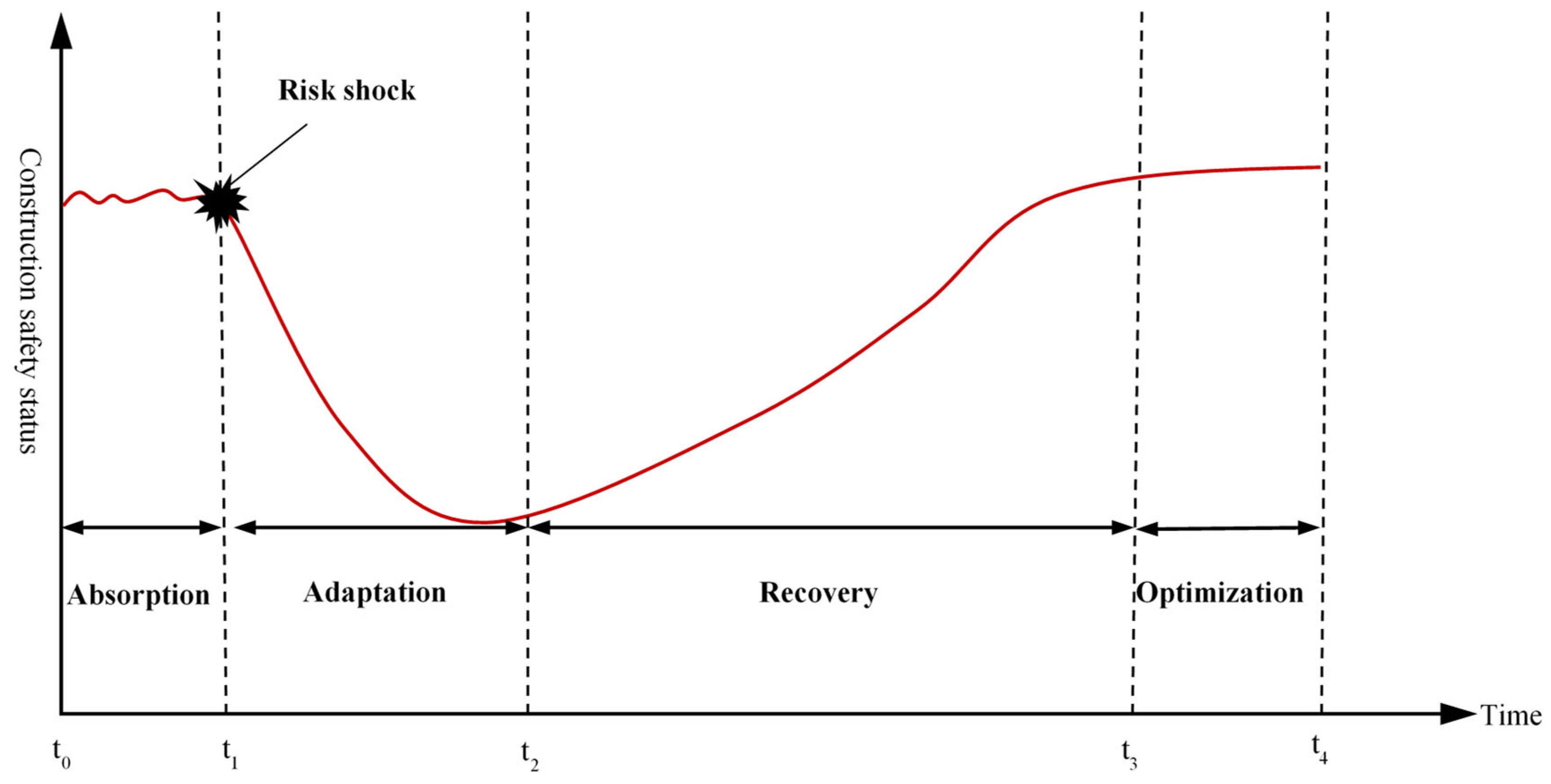
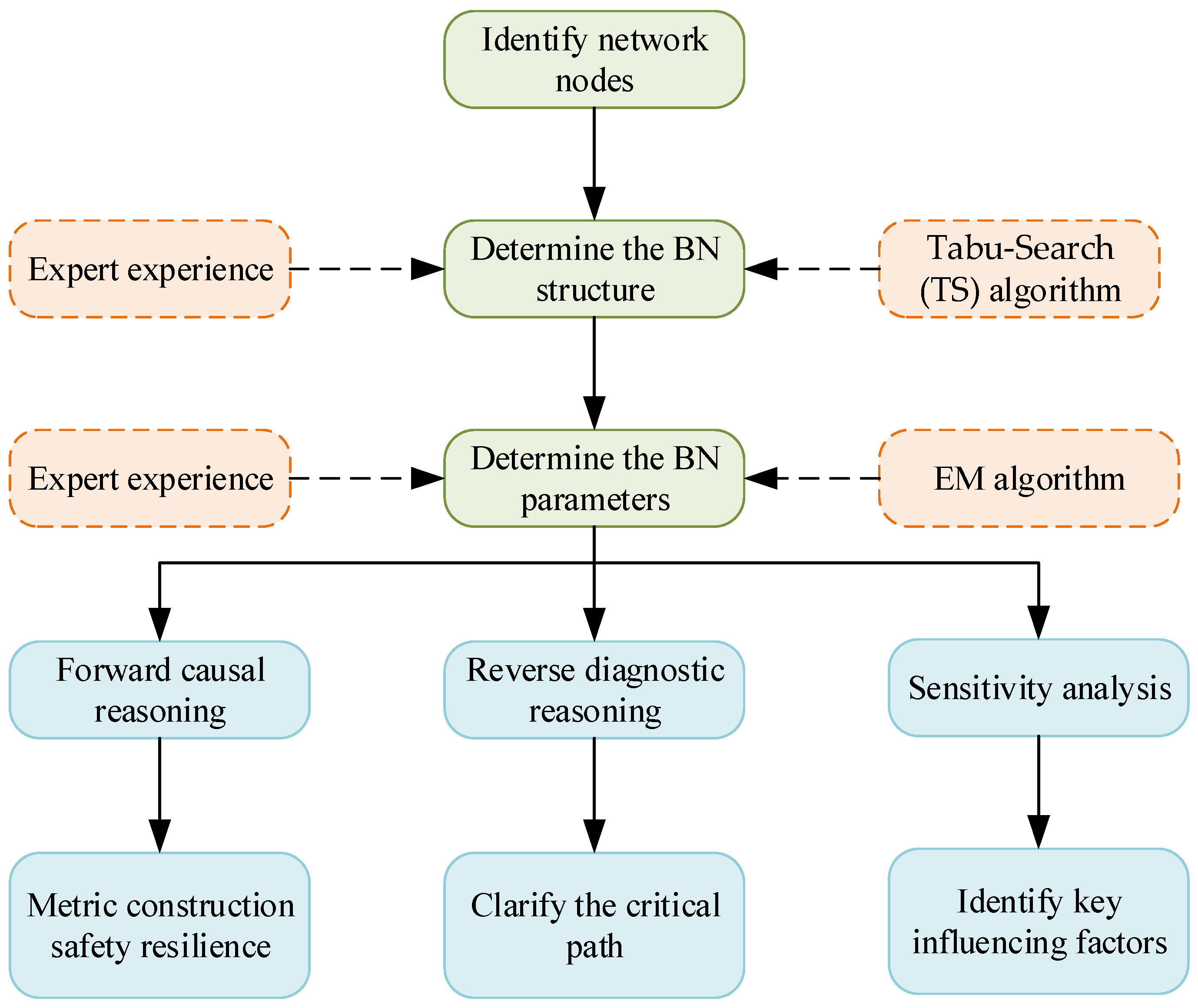
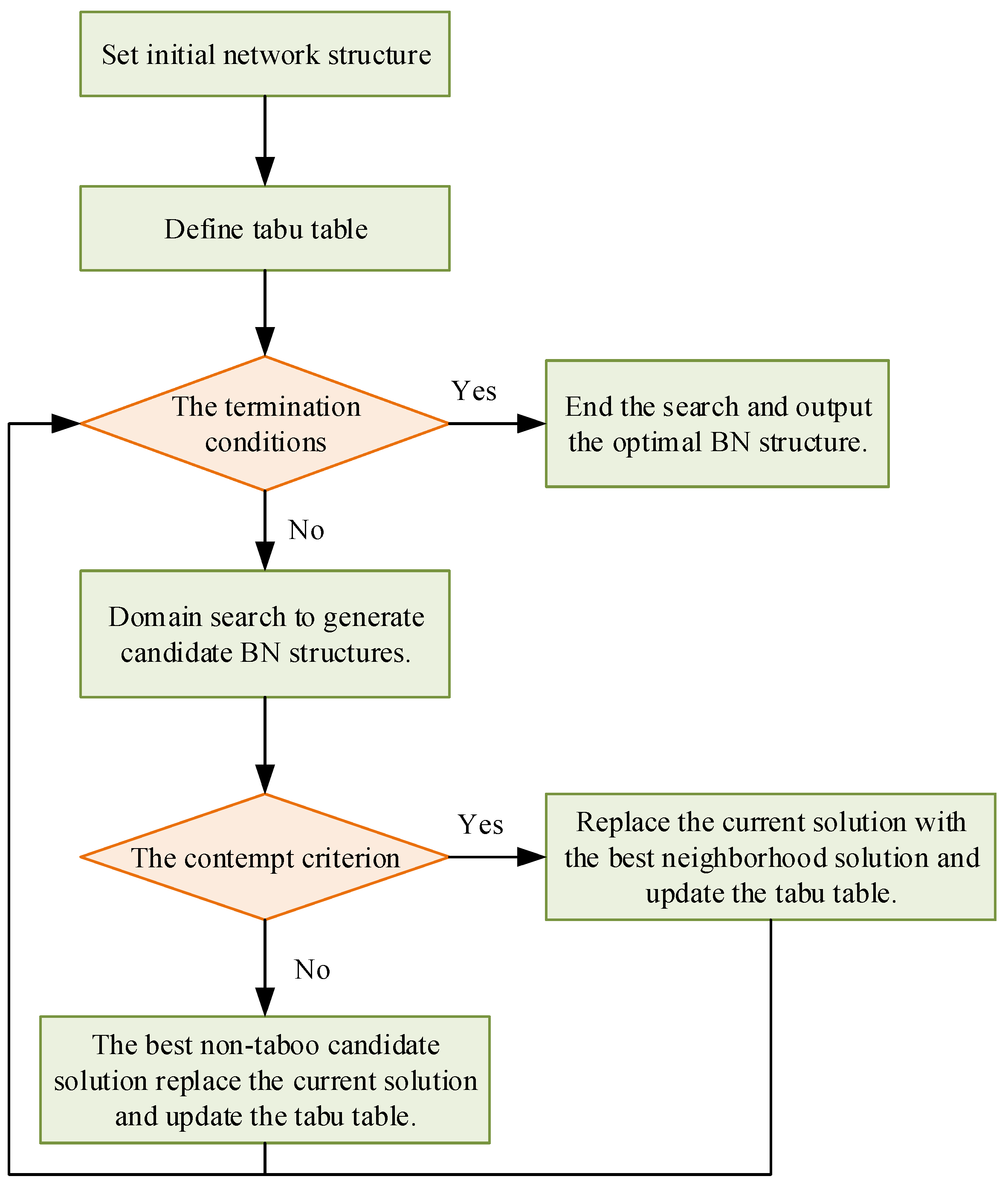
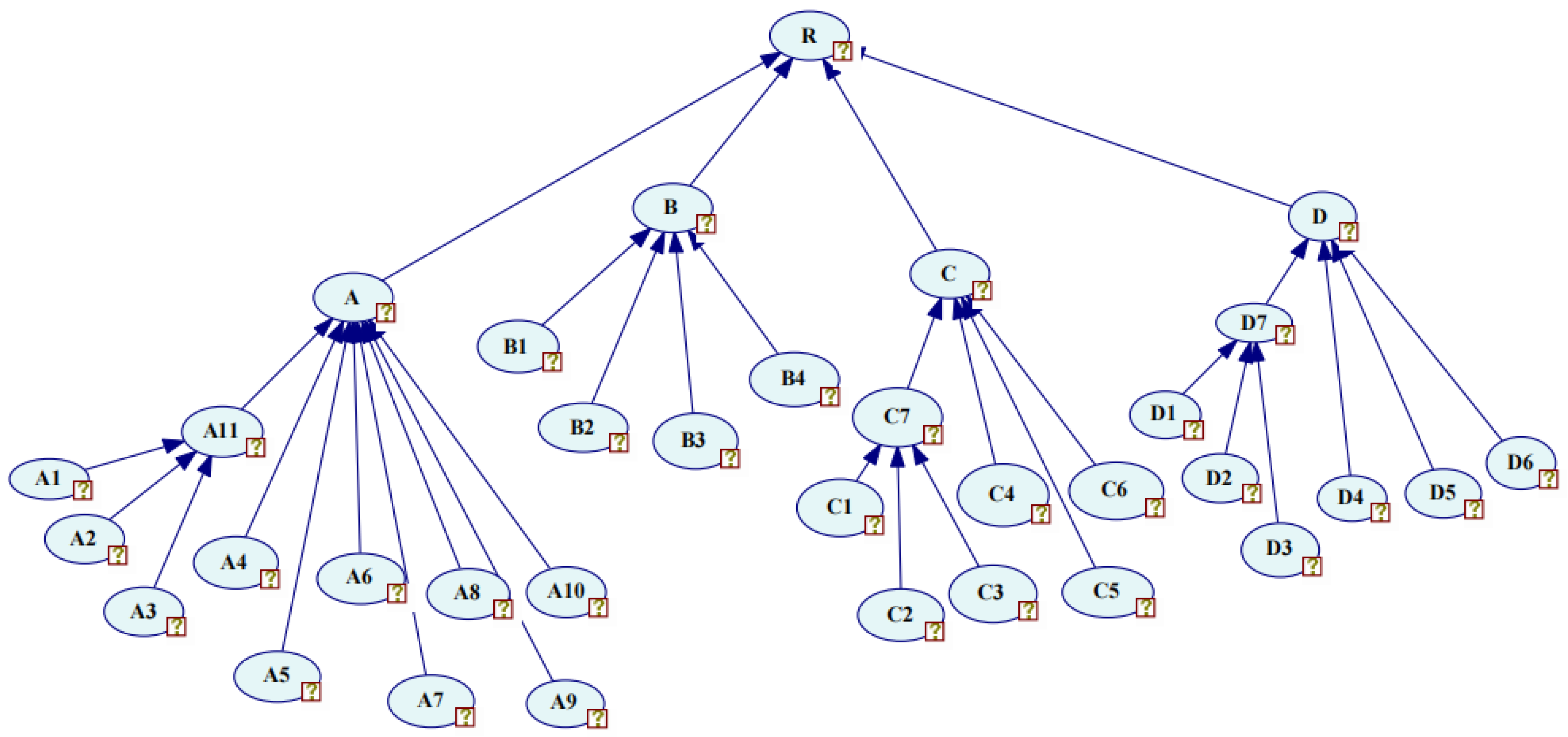
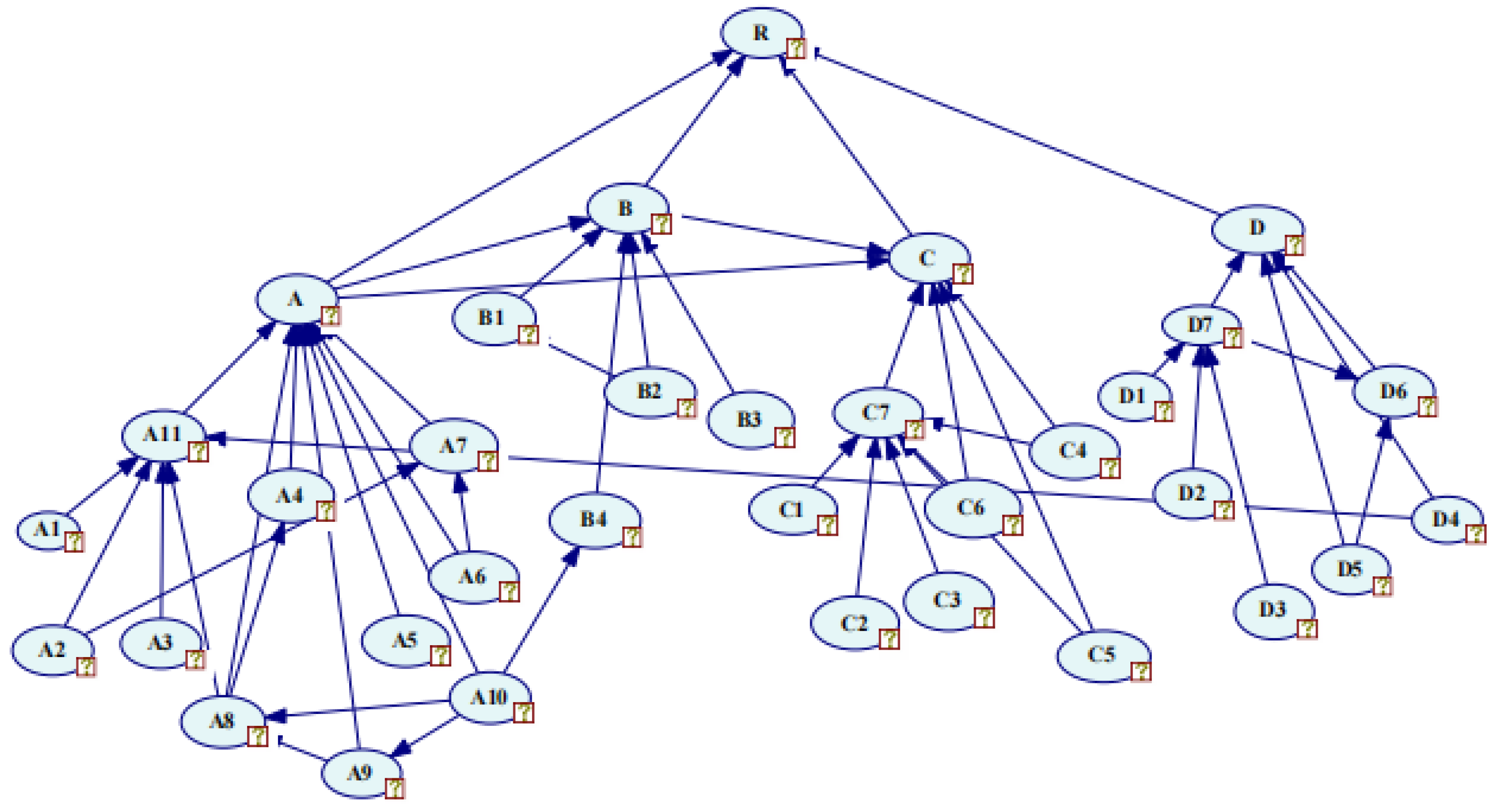
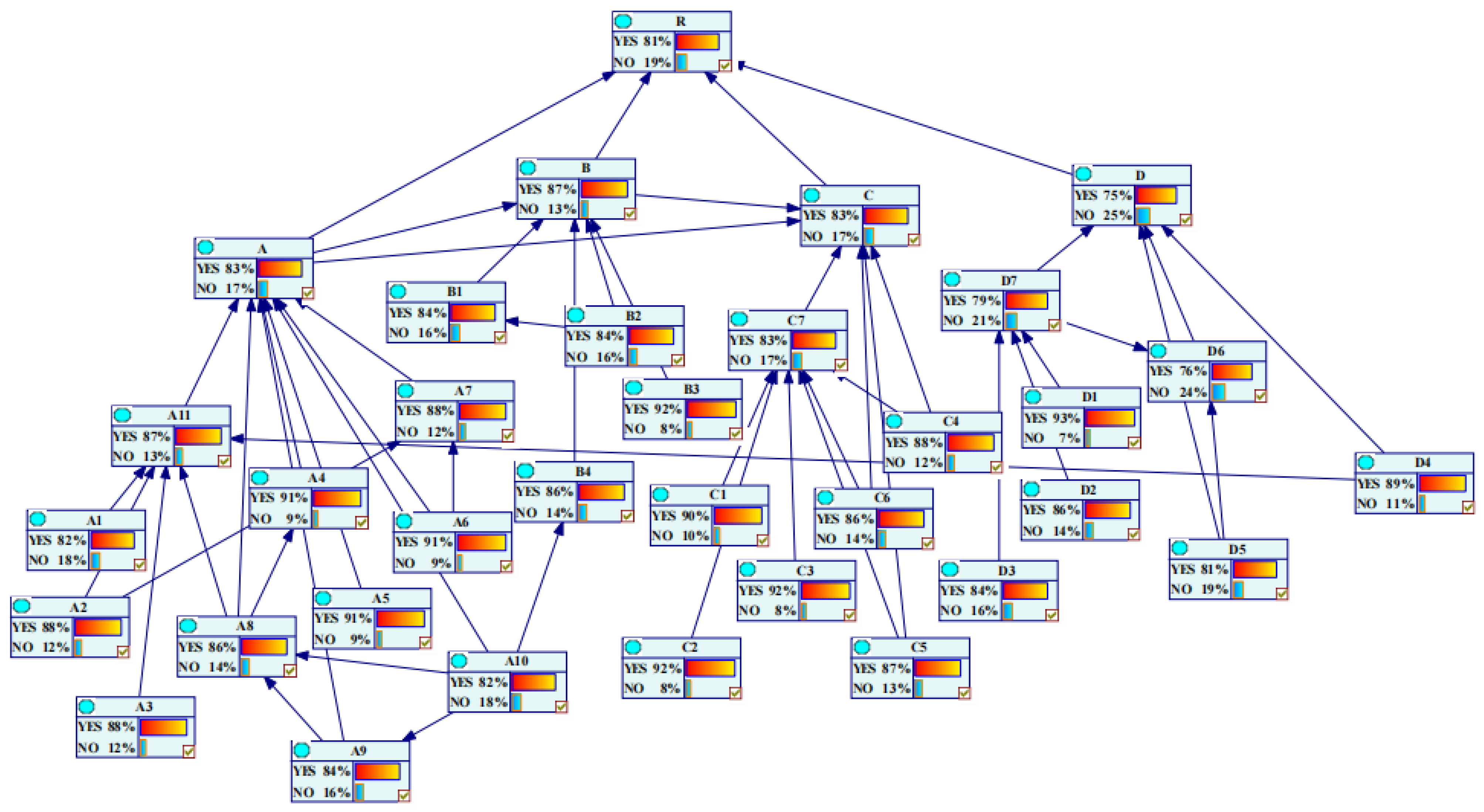
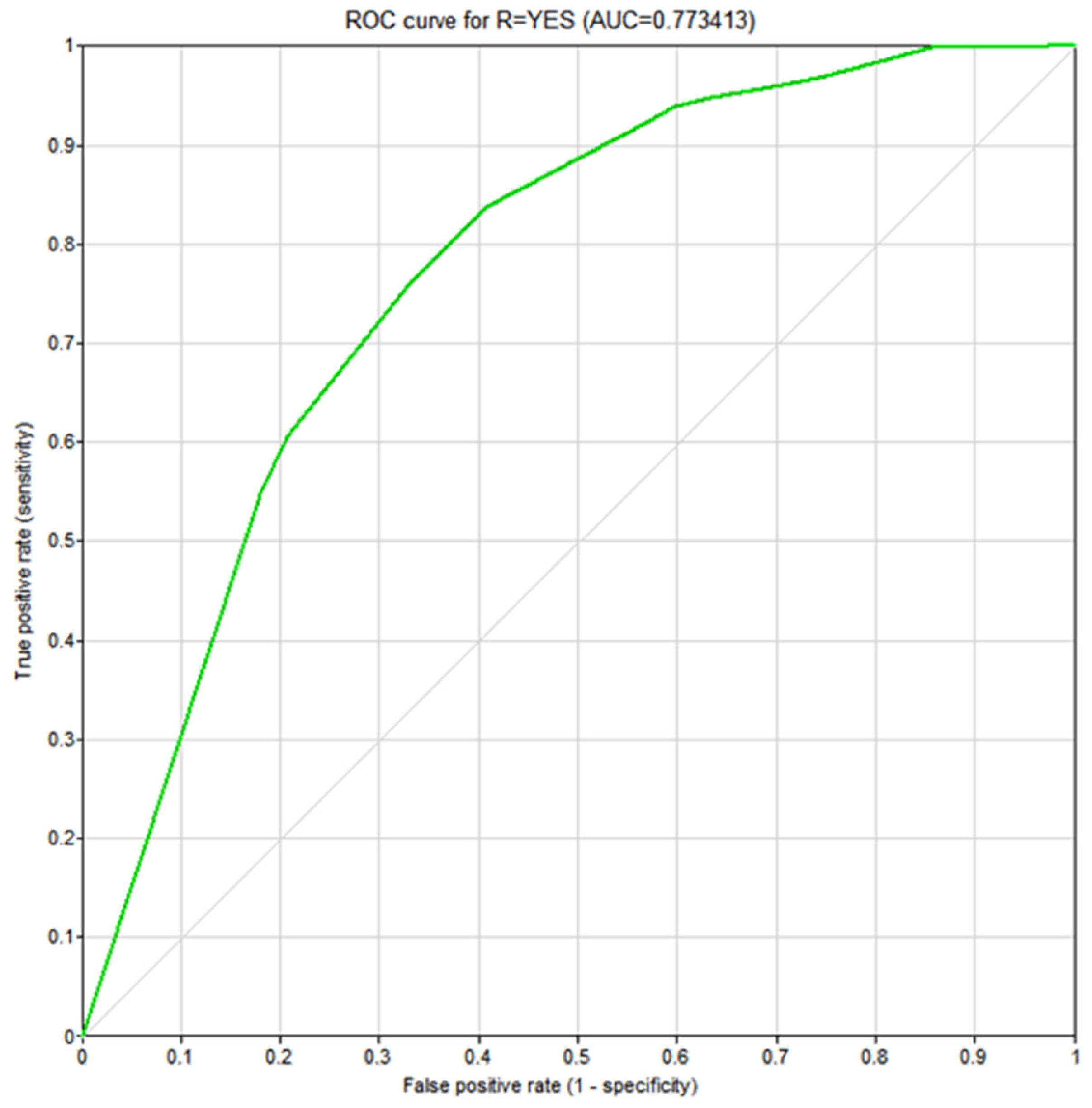
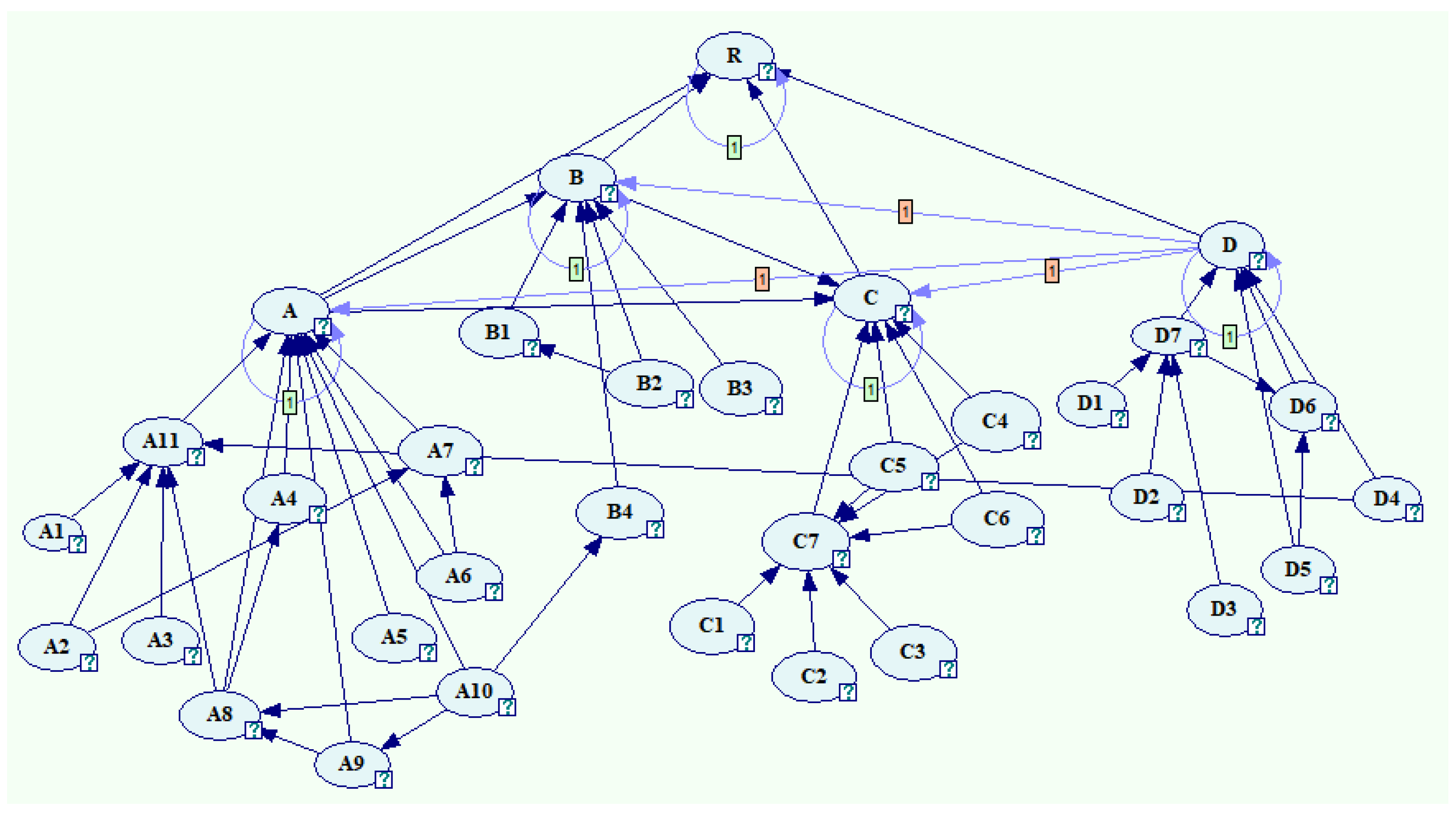

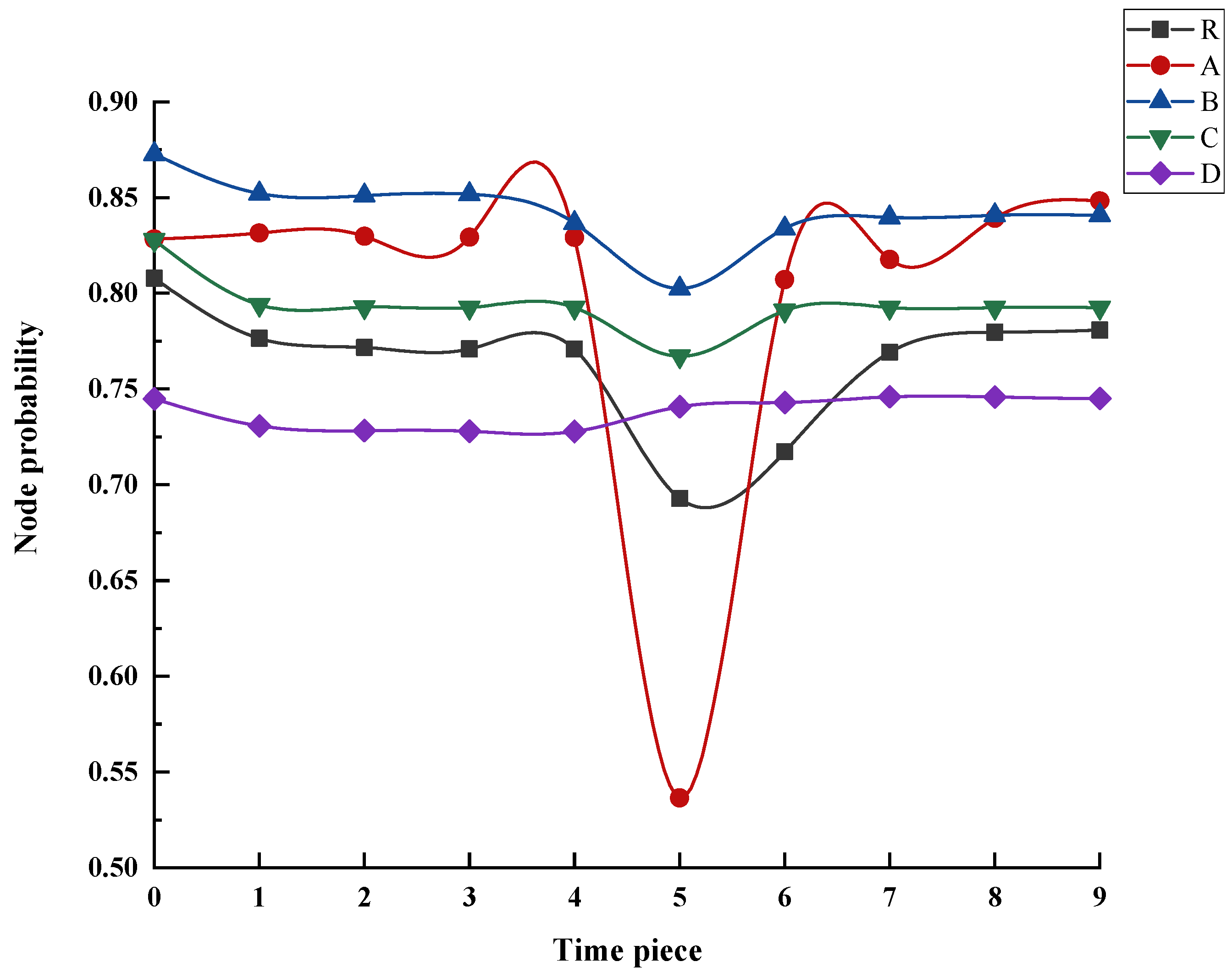
| Target Layer | Primary Indicator | Secondary Indicator | |
|---|---|---|---|
| Prefabricated building construction safety resilience R | Absorption capability A | Safety awareness of personnel A1 | Preventing unsafe behavior of personnel A11 |
| Professional technical level and operational proficiency of personnel A2 | |||
| Personnel physiological and psychological state A3 | |||
| Machinery and equipment condition and performance A4 | |||
| Quality of prefabricated components A5 | |||
| Maturity of key technologies for construction and installation of prefabricated components A6 | |||
| Reliable connection of prefabricated components A7 | |||
| Safety management and supervision on the construction site A8 | |||
| Risk source assessment and countermeasures A9 | |||
| Information monitoring and processing system setup A10 | |||
| Adaptation capability B | Multidimensional cooperation B1 | ||
| Self-organizing ability of the organization B2 | |||
| Substitutability of key resources B3 | |||
| Integrity and efficiency of security messaging B4 | |||
| Recovery capability C | Accident emergency management system C1 | Emergency management actions C7 | |
| Emergency Response Plan C2 | |||
| Emergency access and shelter settings C3 | |||
| Emergency organization and dispatching capability for managers C4 | |||
| Emergency life-saving capabilities for personnel C5 | |||
| Emergency material supply C6 | |||
| Optimization capability D | Accident cause investigation and experience summary D1 | ||
| Establishing security information sharing and management platform D2 | Building a risk management information system D7 | ||
| Intelligent transmission of risk disaster safety early warning information D3 | |||
| Safety education training and drills D4 | |||
| Developing transformational leadership D5 | |||
| Establishing a resilience safety culture D6 | |||
| Predicted Negative | Predicted Positive | |
|---|---|---|
| Actual Negative | TN (True Negative) | FP (False Positive) |
| Actual Positive | FN (False Negative) | TP (True Positive) |
| Predicted Negative | Predicted Positive | |
|---|---|---|
| Actual Negative | 37 | 18 |
| Actual Positive | 25 | 153 |
| Linguistic Terms | Fuzzy Number |
|---|---|
| Very low | (0, 0.1, 0.2) |
| Low | (0.1, 0.2, 0.3) |
| Lower | (0.3, 0.4, 0.5) |
| Moderate | (0.5, 0.6, 0.7) |
| Higher | (0.6, 0.7, 0.8) |
| High | (0.7, 0.8, 0.9) |
| Very high | (0.8, 0.9, 1.0) |
| A(t + 1) | A(t) | B(t + 1) | B(t) | ||
| YES | NO | YES | NO | ||
| YES | 0.84 | 0.33 | YES | 0.82 | 0.38 |
| NO | 0.16 | 0.67 | NO | 0.18 | 0.62 |
| C(t + 1) | C(t) | D(t + 1) | D(t) | ||
| YES | NO | YES | NO | ||
| YES | 0.77 | 0.36 | YES | 0.73 | 0.29 |
| NO | 0.23 | 0.64 | NO | 0.27 | 0.71 |
| R(t + 1) | R(t) | A(t + 1) | D(t) | ||
| YES | NO | YES | NO | ||
| YES | 0.87 | 0.28 | YES | 0.78 | 0.26 |
| NO | 0.13 | 0.72 | NO | 0.22 | 0.74 |
| B(t + 1) | D(t) | C(t + 1) | D(t) | ||
| YES | NO | YES | NO | ||
| YES | 0.65 | 0.33 | YES | 0.71 | 0.31 |
| NO | 0.35 | 0.67 | NO | 0.29 | 0.69 |
| Indicator | Prior Probability | Posterior Probability | Sort | RoV Value | Sort |
|---|---|---|---|---|---|
| Safety awareness of personnel A1 | 0.8236 | 0.8112 | 24 | 0.0151 | 10 |
| Professional technical level and operational proficiency of personnel A2 | 0.8797 | 0.8713 | 11 | 0.0095 | 17 |
| Personnel physiological and psychological state A3 | 0.8837 | 0.8756 | 10 | 0.0092 | 19 |
| Preventing unsafe behavior of personnel A11 | 0.8695 | 0.8365 | 19 | 0.0379 | 2 |
| Machinery and equipment condition and performance A4 | 0.9069 | 0.9004 | 6 | 0.0072 | 20 |
| Quality of prefabricated components A5 | 0.9122 | 0.9092 | 3 | 0.0033 | 25 |
| Maturity of key technologies for construction and installation of prefabricated components A6 | 0.8949 | 0.8911 | 8 | 0.0042 | 24 |
| Reliable connection of prefabricated components A7 | 0.8916 | 0.8875 | 9 | 0.0046 | 23 |
| Safety management and supervision on the construction site A8 | 0.8597 | 0.8296 | 22 | 0.0350 | 3 |
| Risk source assessment and countermeasures A9 | 0.8433 | 0.8353 | 21 | 0.0095 | 18 |
| Information monitoring and processing system setup A10 | 0.8141 | 0.8033 | 26 | 0.0133 | 14 |
| Multidimensional cooperation B1 | 0.8370 | 0.8286 | 23 | 0.0101 | 16 |
| Self-organizing ability of the organization B2 | 0.8517 | 0.8389 | 16 | 0.0150 | 11 |
| Substitutability of key resources B3 | 0.9051 | 0.8923 | 7 | 0.0141 | 13 |
| Integrity and efficiency of security messaging B4 | 0.8502 | 0.8380 | 17 | 0.0143 | 12 |
| Accident emergency management system C1 | 0.9042 | 0.9028 | 5 | 0.0015 | 28 |
| Emergency Response Plan C2 | 0.9136 | 0.9119 | 2 | 0.0019 | 27 |
| Emergency access and shelter settings C3 | 0.9187 | 0.9175 | 1 | 0.0013 | 29 |
| emergency management actions C7 | 0.826 | 0.801 | 27 | 0.0303 | 4 |
| Emergency organization and dispatching capability for managers C4 | 0.8761 | 0.8611 | 14 | 0.0171 | 8 |
| Emergency life-saving capabilities for personnel C5 | 0.8513 | 0.8362 | 20 | 0.0177 | 7 |
| Emergency material supply C6 | 0.8795 | 0.8655 | 13 | 0.0159 | 9 |
| Accident cause investigation and experience summary D1 | 0.9255 | 0.9065 | 4 | 0.0205 | 6 |
| Establishing security information sharing and management platform D2 | 0.8527 | 0.8426 | 15 | 0.0118 | 15 |
| Intelligent transmission of risk disaster safety early warning information D3 | 0.8403 | 0.8376 | 18 | 0.0032 | 26 |
| Building a risk management information system D7 | 0.7828 | 0.7609 | 28 | 0.0280 | 5 |
| Safety education training and drills D4 | 0.8740 | 0.8694 | 12 | 0.0053 | 22 |
| Developing transformational leadership D5 | 0.8116 | 0.8062 | 25 | 0.0067 | 21 |
| Establishing a resilience safety culture D6 | 0.7208 | 0.6898 | 29 | 0.0430 | 1 |
| Indicator | Prior Probability | Posterior Probability | Sort | RoV Value | Sort |
|---|---|---|---|---|---|
| Absorption capacity A | 0.8239 | 0.6422 | 3 | 0.2205 | 1 |
| Adaptation capacity B | 0.8706 | 0.6977 | 1 | 0.1986 | 3 |
| Recovery capacity C | 0.8259 | 0.6521 | 2 | 0.2104 | 2 |
| Optimization capacity D | 0.7224 | 0.6089 | 4 | 0.1571 | 4 |
Disclaimer/Publisher’s Note: The statements, opinions and data contained in all publications are solely those of the individual author(s) and contributor(s) and not of MDPI and/or the editor(s). MDPI and/or the editor(s) disclaim responsibility for any injury to people or property resulting from any ideas, methods, instructions or products referred to in the content. |
© 2024 by the authors. Licensee MDPI, Basel, Switzerland. This article is an open access article distributed under the terms and conditions of the Creative Commons Attribution (CC BY) license (https://creativecommons.org/licenses/by/4.0/).
Share and Cite
Wang, J.; Chen, Z.; Song, Y.; Liu, Y.; He, J.; Ma, S. Data-Driven Dynamic Bayesian Network Model for Safety Resilience Evaluation of Prefabricated Building Construction. Buildings 2024, 14, 570. https://doi.org/10.3390/buildings14030570
Wang J, Chen Z, Song Y, Liu Y, He J, Ma S. Data-Driven Dynamic Bayesian Network Model for Safety Resilience Evaluation of Prefabricated Building Construction. Buildings. 2024; 14(3):570. https://doi.org/10.3390/buildings14030570
Chicago/Turabian StyleWang, Junwu, Zhao Chen, Yinghui Song, Yipeng Liu, Juanjuan He, and Shanshan Ma. 2024. "Data-Driven Dynamic Bayesian Network Model for Safety Resilience Evaluation of Prefabricated Building Construction" Buildings 14, no. 3: 570. https://doi.org/10.3390/buildings14030570
APA StyleWang, J., Chen, Z., Song, Y., Liu, Y., He, J., & Ma, S. (2024). Data-Driven Dynamic Bayesian Network Model for Safety Resilience Evaluation of Prefabricated Building Construction. Buildings, 14(3), 570. https://doi.org/10.3390/buildings14030570








